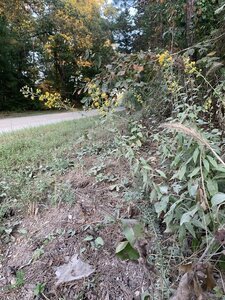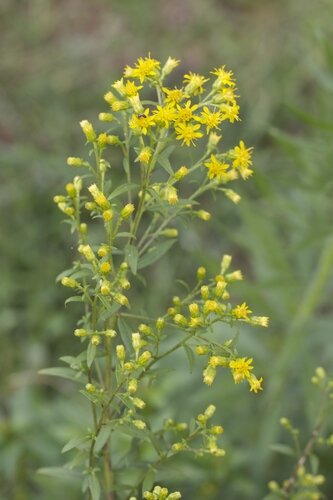When plants become rare, people lose track of them. We often don’t know the full extent of their former range, so we don’t always know where to look. If we’re lucky, they turn up on roadsides and even in people’s yards.
That’s what has happened with the lovely native goldenrod known as Porter’s goldenrod (Solidago porteri). In 2012, this plant was thought to be known only from an herbarium specimen collected in 1846 from Monticello in Jasper Co., Georgia, in the southeastern U.S.A. Then one day, Dwayne Estes (SGI Executive Director) was driving along some back country roads in his home county of Giles Co, Tennessee, and a goldenrod growing on the roadside caught his eye. It just looked different.
Giles County roadside population originally discovered by Dwayne Estes, now under management.
S porteri at roadside/Dwayne Estes
Fast forward a few years, and this rare species, once thought extinct, is now known to have three tiny populations: one in Giles County, one in Alabama (which may have almost been extirpated when a road was widened), and one that was spotted by a plant enthusiast in her yard in 2015 Cherokee Co, Georgia!
Solidago porteri
It takes a village
The S. porteri site in Tennessee has become an exciting place for SGI, volunteers, and for many partner organizations. Cooper Breeden, Plant Conservation Coordinator for both SGI and the Tennessee Plant Conservation Alliance (TPCA), is leading a multi-pronged project designed to protect this population while expanding the species range through seed banking and reintroductions!
As luck would have it, the Giles Co. site is an actively managed loblolly pine plantation owned by The Rohatyn Group and managed by American Forest Management (AFM). They have proven very amenable to collaborating with the Tennessee Division of Natural Areas and SGI to protect the Porter’s goldenrod. In 2020, AFM agreed to set aside 2 of their 125 acres as a reserve for the goldenrod. They also agreed to thin the plot, by reducing the number of pines and restoring the site to a savanna—a grassland habitat consisting of scattered trees.
S. porteri site in Giles County, TN after thinning by American Forestry Management, but before shrub removal by volunteers/Cooper Breeden.
“I was impressed with the thinning results,” said Cooper. “They clearly understood the need to be more careful than is typical in a standard harvest, and they did a great job of minimizing the impact on the site.”
The Division of Natural Areas is seeking to make the 2-acre site a registered State Natural Area, which involves an agreement with the landowner. They have another similar agreement with AFM at a site containing several federally and state listed plants.
Volunteer stewards and other essential management
On-site activity involves both management and research at various levels. It has also involved elbow grease donated by 11 volunteers who spent a day cutting back the shrubby understory which will complement the thinning of the loblollies. This will allow more light to reach the ground floor and promote the growth of more grasses and wildflowers. In the course of an afternoon, they cut down about 90% of the shrubs and small trees in the 2-acre area and painted the stumps with herbicide to prevent resprouting.
S. porteri workday in Tennessee/Rebecca Johnson
"Most of the volunteer field work I’ve done has been invasive plant removal,” explained S. porteri volunteer Richard Hitt. “Because of that, I find it especially exciting to have an opportunity to help save a critically imperiled plant species like Porter's Goldenrod. Helping to restore the habitat of an endangered plant species is very rewarding and very necessary. With worldwide biodiversity in serious decline, we all have to work together to help preserve species."
“We are monitoring the results of the management in a few different ways,” explained Cooper. “First, we set up a permanent vegetation plot prior to thinning and can compare species composition from year to year. We also collected soil samples from the plot, which we’ll germinate in controlled conditions to test whether there may be a seed bank of species that we didn’t see while monitoring. We also took several strategic photos facing multiple directions as a way of visually showing the results of management through the years.”
Another highly important stewardship activity will be a controlled burn this winter during the dormant season. This will reduce years of pine needle and downed wood accumulation and promote a fire-adapted herbaceous layer. Once again, AFM has stepped up as a valuable partner and will be coordinating all aspects of the controlled burn.
The big picture behind a small plant
Why, you might be asking, is it necessary to cut down trees to save this goldenrod? All three populations of Porter’s goldenrod, in Alabama, Tennessee, and Georgia, are situated in an area that was historically dominated by a mix of native grassland and oak savanna, areas often referred to as “barrens” in historical accounts.
Much of this region, however, has succeeded over the past 100 to 200 years into oak-hickory woodland and forest, mainly due to fire suppression and the loss of large herds of ungulates such as bison. In turn, much of the oak-hickory woodlands have been cut and some, such as the site in Giles Co., TN, have been converted to loblolly (the loblolly’s natural range begins just a bit south of Giles Co.).
Today, the presence of scrubby post oaks and blackjack oaks, the typical oaks of the barrens, are indicators of the once former grassland savanna, and remnants of this once extensive barrens vegetation are found mostly along roadsides—precisely where Dwayne rediscovered the goldenrod.
Beyond safeguarding what is left
The focus of SGI’s efforts and that of our partners goes way beyond safeguarding what is left. One of the goals of both SGI and the TPCA is to increase the capacity for plant conservation in Tennessee and beyond. As such, Cooper is working to bring new partners into the plant conservation fold. As it relates to Porter’s goldenrod, they are collaborating with the horticultural staff at the Nashville Zoo on ex situ (off site) conservation efforts, which would be their first involvement in a TPCA project. The zoo will grow out the plants and incorporate them into a safeguarding and educational garden. Eventually, these plants may be the source for introducing the goldenrod into a protected site.
Rare plants are not always difficult to grow from seed, and that is true of the Porter’s goldenrod. In such cases, it may not be necessary to rely on propagation experts, and conservationists can seek help from nontraditional partners. To that end, SGI, TN Division of Natural Areas botanists, and the Nashville Zoo will be working with a local Girl Scout, who plans to help grow additional Porter’s goldenrod plants for future conservation efforts.
Girl Scout Alyssa Goodman, third from left, holding a tray of Porter’s goldenrods propagated from seeds collected in Giles Co. TN, to be planted at the Nashville Zoo. Also pictured: David Farrow, Nashville Zoo; Cooper Breeden, SGI; Caitlin Elam, TN Div of Natural Areas.
In the meantime, Cooper is also working with Tennessee Natural Heritage staff to locate protected land where it would be appropriate to do an introduction in the future.
The Porter's goldenrod is not federally endangered or threatened, but it is without a doubt among one of our most imperiled plants in the state of Tennessee, and maybe even in the Southeast. However, thanks to the efforts of many—state agencies, nonprofits, volunteers, researchers, and donors—the future of Porter’s goldenrod is looking as bright as its tiny golden flowers in autumn!
Solidago porteri/Dwayne Estes







